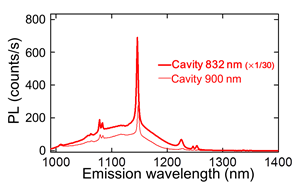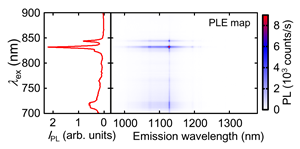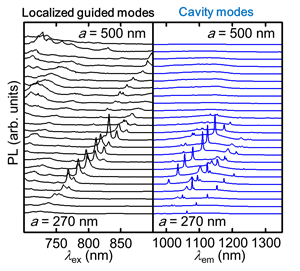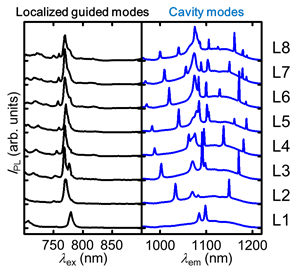Research:Localized guided-mode and cavity-mode double resonance in photonic crystal nanocavities
Doubly resonant cavities allow for strong enhancement of luminecence when both emission and excitations are simultaneously in resonance. In particular, because carbon nanotubes show sharp resonances in both emission and absorption, significant enhancement is expected. Here we investigate the use of localized guided-modes and cavity-modes for achieving double resonances in photonic crystal nanocavities.
Our devices are linear defect L-type cavities in hexagonal lattice photonic crystal slabs, and we fabricate them from silicon-on-insulator wafers. We characterize the devices by photoluminescence (PL) microscopy. If we take a PL spectrum at the cavity with an excitation wavelength of 900 nm, we observe clear peaks showing that silicon PL is enhanced by the cavity modes. Interestingly, when the excitation wavelength is tuned to 832 nm, we observe an approximate fifty-fold increase in the PL intensity throughout the spectrum. In order to study this PL enhancement in detail, we have taken the laser wavelength dependence of PL spectra at the cavity to construct a PL excitation (PLE) map. The vertical line in the map corresponds to a cavity mode, while the horizontal line shows the excitation resonance responsible for the PL enhancement. To characterize the excitation resonance, we plot the PL intensity as a function of the excitation wavelength. Several sharp resonances are observed in the spectrum, and these resonances correspond to localized guided modes.At the intersection of the vertical and horizontal lines, we achieve a localized guided-mode and cavity-mode double resonance.


We further perform lattice-constant and cavity-length dependence measurements to control the localized guided-mode and cavity-mode double resonances in our devices. We find that the localized guided modes can be tuned by changing the lattice constant, while changing cavity length allows independent tuning of cavity modes. This technique offers a simple method for achieving double resonance in a nanocavity and is expected to be useful for enhancing PL and wavelength conversion efficiencies in a wide variety of systems.


To learn more about this work, please refer to:
Localized guided-mode and cavity-mode double resonance in photonic crystal nanocavities
Phys. Rev. Applied
3, 014006 (2015).
![]()